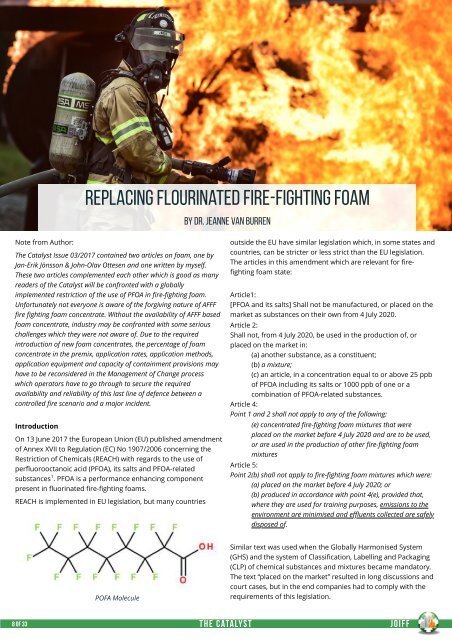The CATALYST_October_2017
Create successful ePaper yourself
Turn your PDF publications into a flip-book with our unique Google optimized e-Paper software.
Replacing Flourinated Fire-Fighting Foam<br />
By Dr. Jeanne van Burren<br />
Note from Author:<br />
<strong>The</strong> Catalyst Issue 03/<strong>2017</strong> contained two articles on foam, one by<br />
Jan-Erik Jönsson & John-Olav Ottesen and one written by myself.<br />
<strong>The</strong>se two articles complemented each other which is good as many<br />
readers of the Catalyst will be confronted with a globally<br />
implemented restriction of the use of PFOA in fire-fighting foam.<br />
Unfortunately not everyone is aware of the forgiving nature of AFFF<br />
fire fighting foam concentrate. Without the availability of AFFF based<br />
foam concentrate, industry may be confronted with some serious<br />
challenges which they were not aware of. Due to the required<br />
introduction of new foam concentrates, the percentage of foam<br />
concentrate in the premix, application rates, application methods,<br />
application equipment and capacity of containment provisions may<br />
have to be reconsidered in the Management of Change process<br />
which operators have to go through to secure the required<br />
availability and reliability of this last line of defence between a<br />
controlled fire scenario and a major incident.<br />
Introduction<br />
On 13 June <strong>2017</strong> the European Union (EU) published amendment<br />
of Annex XVII to Regulation (EC) No 1907/2006 concerning the<br />
Restriction of Chemicals (REACH) with regards to the use of<br />
perfluorooctanoic acid (PFOA), its salts and PFOA-related<br />
substances 1 . PFOA is a performance enhancing component<br />
present in fluorinated fire-fighting foams.<br />
REACH is implemented in EU legislation, but many countries<br />
outside the EU have similar legislation which, in some states and<br />
countries, can be stricter or less strict than the EU legislation.<br />
<strong>The</strong> articles in this amendment which are relevant for firefighting<br />
foam state:<br />
Article1:<br />
[PFOA and its salts] Shall not be manufactured, or placed on the<br />
market as substances on their own from 4 July 2020.<br />
Article 2:<br />
Shall not, from 4 July 2020, be used in the production of, or<br />
placed on the market in:<br />
(a) another substance, as a constituent;<br />
(b) a mixture;<br />
(c) an article, in a concentration equal to or above 25 ppb<br />
of PFOA including its salts or 1000 ppb of one or a<br />
combination of PFOA-related substances.<br />
Article 4:<br />
Point 1 and 2 shall not apply to any of the following:<br />
(e) concentrated fire-fighting foam mixtures that were<br />
placed on the market before 4 July 2020 and are to be used,<br />
or are used in the production of other fire-fighting foam<br />
mixtures<br />
Article 5:<br />
Point 2(b) shall not apply to fire-fighting foam mixtures which were:<br />
(a) placed on the market before 4 July 2020; or<br />
(b) produced in accordance with point 4(e), provided that,<br />
where they are used for training purposes, emissions to the<br />
environment are minimised and effluents collected are safely<br />
disposed of.<br />
POFA Molecule<br />
Similar text was used when the Globally Harmonised System<br />
(GHS) and the system of Classification, Labelling and Packaging<br />
(CLP) of chemical substances and mixtures became mandatory.<br />
<strong>The</strong> text “placed on the market” resulted in long discussions and<br />
court cases, but in the end companies had to comply with the<br />
requirements of this legislation.<br />
8 of 33 <strong>The</strong> Catalyst JOIFF

















